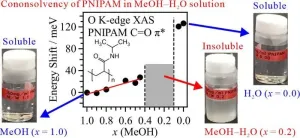(Press-News.org) Stroke is the leading cause of disability worldwide and the second leading cause of death, but the right early intervention can prevent severe consequences. A new study led by investigators from Brigham and Women’s Hospital, a founding member of the Mass General Brigham healthcare system, and collaborators developed a new test by combining blood-based biomarkers with a clinical score to identify patients experiencing large vessel occlusion (LVO) stroke with high accuracy. Their results are published in the journal Stroke: Vascular and Interventional Neurology.
“We have developed a game-changing, accessible tool that could help ensure that more people suffering from stroke are in the right place at the right time to receive critical, life-restoring care,” said senior author Joshua Bernstock, MD, PhD, MPH, a clinical fellow in the Department of Neurosurgery at Brigham and Women’s Hospital.
Most strokes are ischemic, in which blood flow to the brain is obstructed. LVO strokes are an aggressive type of ischemic stroke that occurs when an obstruction occurs in a major artery in the brain. When blood supply to the brain is compromised, the lack of oxygen and nutrients causes brain cells to die within minutes. LVO strokes are major medical emergencies and require the swift treatment with mechanical thrombectomy, a surgical procedure that retrieves the blockage.
“Mechanical thrombectomy has allowed people that otherwise would have died or become significantly disabled be completely restored, as if their stroke never happened,” said Bernstock. “The earlier this intervention is enacted, the better the patient’s outcome is going to be. This exciting new technology has the potential to allow more people globally to get this treatment faster.”
The research team previously targeted two specific proteins found in capillary blood, one called glial fibrillary acidic protein (GFAP), which is also associated with brain bleeds and traumatic brain injury, and one called D-dimer. In this study, they demonstrated that the levels of these blood-based biomarkers combined with field assessment stroke triage for emergency destination (FAST-ED) scores could identify LVO ischemic strokes while ruling out other conditions such as bleeding in the brain. Brain bleeds cause similar symptoms to LVO stroke, making them hard to distinguish from one another in the field, yet treatment for each is vastly different.
In this prospective, observational diagnostic accuracy study, the researchers looked at data from a cohort of 323 patients coded for stroke in Florida between May 2021 and August 2022. They found that combining the levels of the biomarkers GFAP and D-dimer with FAST-ED data less than six hours from the onset of symptoms allowed the test to detect LVO strokes with 93 percent specificity and 81 percent sensitivity. Other findings included that the test ruled out all patients with brain bleeds, signaling that the technology may ultimately also be employed to detect intracerebral hemorrhage in the field.
Bernstock’s team also sees promising potential future use of this accessible diagnostic tool in low- and middle-income countries, where advanced imaging is not always available. It might also be useful in assessing patients with traumatic brain injuries. Next, they are carrying out another prospective trial to measure the test’s performance when used in an ambulance. They have also designed an interventional trial that leverages the technology to expedite the triage of stroke patients by having them bypass standard imaging and move directly to intervention.
“In stroke care, time is brain,” Bernstock said. “The sooner a patient is put on the right care pathway, the better they are going to do. Whether that means ruling out bleeds or ruling in something that needs an intervention, being able to do this in a prehospital setting with the technology that we built is going to be truly transformative.”
Authorship: Additional authors include Yasir Durrani, Jakob V. E. Gerstl, Danielle Murphy, Ashley Harris, Imane Saali, Toby Gropen, Shashank Shekhar, Ari D. Kappel, Nirav J. Patel, Rose Du, Rodolfo E. Alcedo Guardia, Juan C. Vicenty-Padilla, Adam A. Dmytriw, Vitor Mendes Pereira, Saef Izzy, Allauddin Khan, Mohammed A. Aziz-Sultan, David S. Liebeskind, Jason M. Davies, Adnan H. Siddiqui, and Edoardo Gaude.
Disclosures: Edoardo Guade declares grant funding from the UK Research and Innovation small business
research initiative. Edoardo Guade and Joshua Bernstock have positions and equity in Pockit Diagnostics Ltd. Joshua Bernstock also has an equity position in Treovir Inc. and is on the boards of Centile Bio and
NeuroX1.
Funding: This study was supported by Innovate UK grant 104640 and by private funding.
Paper cited: Durrani Y, et al. “Prospective validation of GFAP, D-dimer and clinical scales for acute large vessel occlusion ischemic stroke detection.” Stroke: Vascular and Interventional Neurology, DOI: 10.1161/SVIN.123.001304
END
Researchers develop “game-changing” blood test for stroke detection
The Testing for Identification of Markers of Stroke (TIME) trial demonstrates the accuracy of a new blood test that can quickly and accurately identify an aggressive type of stroke with the potential to bring life-saving care to patients globally
2024-05-17
ELSE PRESS RELEASES FROM THIS DATE:
New guideline: Barrett’s esophagus can precede esophageal cancer, but not all patients need a procedure to remove abnormal cells
2024-05-17
Bethesda, MD (May 17, 2024) — The American Gastroenterological Association’s (AGA) new evidence-based Clinical Practice Guideline on Endoscopic Eradication Therapy of Barrett's Esophagus and Related Neoplasia, published today in Gastroenterology, establishes updated guidance for Barrett’s esophagus patients.
A precursor to esophageal cancer, Barrett’s esophagus is a condition in which the cells in the esophagus have been replaced with non-cancerous abnormal cells. These cells can progress to a condition called dysplasia, which may in turn become cancer. Dysplasia is considered low-grade or ...
Researchers in Portugal develop an image analysis AI platform to boost worldwide research
2024-05-17
A team of researchers from the Instituto Gulbenkian de Ciência (IGC) in Portugal, together with Åbo Akademi University in Finland, the AI4Life consortium, and other collaborators, have developed an innovative open-source platform called DL4MicEverywhere published today in the journal Nature Methods*. This platform provides life scientists with easy access to advanced artificial intelligence (AI) for the analysis of microscopy images. Itenables other researchers, ...
A devastating fire 2,200 years ago preserved a moment of life and war in Iron Age Spain — right down to a single gold earring
2024-05-17
A ruined building in the middle of the Pyrenees records a tragedy for the people who lived there — a devastating fire which burned a settlement to the ground, destroying everything down to a hidden gold earring. Now archaeologists’ excavation of Building G, in the strategically placed Iron Age site of Tossal de Baltarga, reveals a way of life derailed by violence: potentially, a forgotten episode of the war between Carthage and Rome.
“The destruction was dated around the end of the third century BCE, the moment where the Pyrenees were involved in the Second Punic War and the passage of Hannibal’s troops,” ...
Exploration of polymer cononsolvency mechanism through soft X-ray absorption spectroscopy
2024-05-17
This study investigates the cononsolvency mechanism of poly(N-isopropylacrylamide) (PNIPAM), which is soluble in pure methanol (MeOH) and water but insoluble in aqueous MeOH solutions. Combining oxygen K-edge X-ray absorption spectroscopy (XAS) with theoretical calculations executed in molecular dynamics (MD) simulations and inner-shell calculations, it was found that hydrophobic interactions between PNIPAM and MeOH clusters play a key role in PNIPAM aggregation and cononsolvency emergence.
PNIPAM is ...
Researchers use machine-learning modeling tools to improve zinc-finger nuclease editing technology
2024-05-17
Genome editing is making inroads into biomedical research and medicine. By employing biomolecule modeling tools, a Japanese research team is accelerating the pace and cutting the cost of zinc finger nuclease (ZFN) technology, a primary gene editing tool.
In a recently published study, researchers from Hiroshima University and the Japanese National Institute of Advanced Industrial Science and Technology demonstrated how machine learning-driven modular assembly systems can improve gene editing.
The study was published on April 10 in the journal Advanced Science.
“Genome editing is ...
USC researcher awarded $3.1 million to study early brain development of babies born to mothers with diabetes in pregnancy
2024-05-17
It has long been understood that pregnant women with diabetes are more likely to have children with obesity than women who do not have diabetes during pregnancy. But scientists have not fully understood the cause or why babies born to mothers with diabetes are also more likely to develop obesity and associated metabolic disorders later in life.
To help find answers, Keck School of Medicine of USC researcher Shan Luo, PhD, has been awarded $3.1 million in funding from the National Institutes of Health and the National Institute of Diabetes ...
Men at greater risk of major health effects of diabetes than women
2024-05-17
Men are at greater risk than women of the major health effects of diabetes (types 1 and 2), suggests a long term study published online in the Journal of Epidemiology & Community Health.
Rates of cardiovascular disease, leg, foot, and kidney complications, and the sight-threatening eye disease diabetic retinopathy are all higher in men, regardless of whether they had diabetes for more or less than 10 years, the findings show.
The global prevalence of diabetes is similar in men and women, and is projected to rise to 783 million by 2045, note the researchers.
But ...
Likelihood of kids and young people smoking and vaping linked to social media use
2024-05-17
The more time spent on social media, the greater the likelihood that children and young people will both smoke and/or vape, suggests research published online in the respiratory journal Thorax.
Clocking up a weekday tally of 7 or more hours was associated with a more than a doubling in risk among 10 to 25 year olds, the findings indicate, reinforcing concerns about the marketing clout of these platforms, say the researchers.
The existing body of research on social media use and smoking and ...
Global life expectancy to increase by nearly 5 years by 2050 despite geopolitical, metabolic, and environmental threats, reports new global study
2024-05-17
**Embargo: 23.30 [UK time], 6:30 p.m. [EDT] May 16, 2024**
Global Burden of Disease
The latest findings from the Global Burden of Disease Study (GBD) 2021, published today in The Lancet, forecast that global life expectancy will increase by 4.9 years in males and 4.2 years in females between 2022 and 2050.
Increases are expected to be largest in countries where life expectancy is lower, contributing to a convergence of increased life expectancy across geographies. The trend is largely driven by public health measures that ...
High primary health coverage significantly reduces child mortality in Latin America
2024-05-17
The implementation of primary health care (PHC) over the last two decades has prevented more than 300,000 child deaths in four Latin American countries, and could prevent more than 140,000 by 2030 in a scenario of economic crisis. This is the main conclusion of a study coordinated by the Barcelona Institute for Global Health (ISGlobal), a centre supported by “la Caixa” Foundation, published in The Lancet Global Health.
The 2018 Astana Declaration highlighted the critical role of PHC in ensuring that everyone enjoys the highest possible standard of health, and in achieving universal health coverage. The Declaration also stressed the ...
LAST 30 PRESS RELEASES:
Tracing the quick synthesis of an industrially important catalyst
New software sheds light on cancer’s hidden genetic networks
UT Health San Antonio awarded $3 million in CPRIT grants to bolster cancer research and prevention efforts in South Texas
Third symposium spotlights global challenge of new contaminants in China’s fight against pollution
From straw to soil harmony: International team reveals how biochar supercharges carbon-smart farming
Myeloma: How AI is redrawing the map of cancer care
Manhattan E. Charurat, Ph.D., MHS invested as the Homer and Martha Gudelsky Distinguished Professor in Medicine at the University of Maryland School of Medicine
Insilico Medicine’s Pharma.AI Q4 Winter Launch Recap: Revolutionizing drug discovery with cutting-edge AI innovations, accelerating the path to pharmaceutical superintelligence
Nanoplastics have diet-dependent impacts on digestive system health
Brain neuron death occurs throughout life and increases with age, a natural human protein drug may halt neuron death in Alzheimer’s disease
SPIE and CLP announce the recipients of the 2025 Advanced Photonics Young Innovator Award
Lessons from the Caldor Fire’s Christmas Valley ‘Miracle’
Ant societies rose by trading individual protection for collective power
Research reveals how ancient viral DNA shapes early embryonic development
A molecular gatekeeper that controls protein synthesis
New ‘cloaking device’ concept to shield sensitive tech from magnetic fields
Researchers show impact of mountain building and climate change on alpine biodiversity
Study models the transition from Neanderthals to modern humans in Europe
University of Phoenix College of Doctoral Studies releases white paper on AI-driven skilling to reduce burnout and restore worker autonomy
AIs fail at the game of visual “telephone”
The levers for a sustainable food system
Potential changes in US homelessness by ending federal support for housing first programs
Vulnerability of large language models to prompt injection when providing medical advice
Researchers develop new system for high-energy-density, long-life, multi-electron transfer bromine-based flow batteries
Ending federal support for housing first programs could increase U.S. homelessness by 5% in one year, new JAMA study finds
New research uncovers molecular ‘safety switch’ shielding cancers from immune attack
Bacteria resisting viral infection can still sink carbon to ocean floor
Younger biological age may increase depression risk in older women during COVID-19
Bharat Innovates 2026 National Basecamp Showcases India’s Most Promising Deep-Tech Ventures
Here’s what determines whether your income level rises or falls
[Press-News.org] Researchers develop “game-changing” blood test for stroke detectionThe Testing for Identification of Markers of Stroke (TIME) trial demonstrates the accuracy of a new blood test that can quickly and accurately identify an aggressive type of stroke with the potential to bring life-saving care to patients globally




